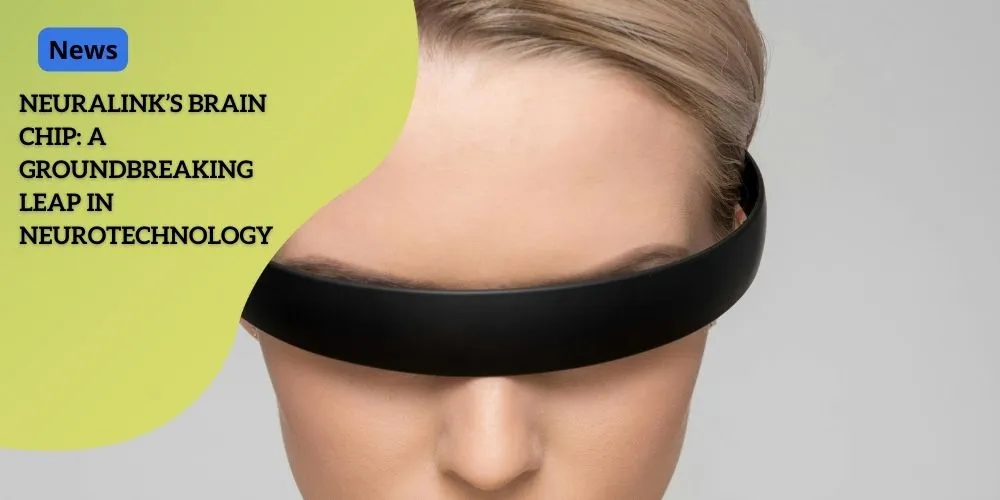Neuralink’s Brain Chip: A Groundbreaking Leap in Neurotechnology

Anúncios
Introduction:
Neuralink’s Pioneering Venture into Brain-Computer Interfaces
The Fascination with Merging Human Consciousness and AI
The allure of integrating human consciousness with artificial intelligence has captivated humanity for decades. This concept, often depicted in science fiction, kindles visions of unparalleled cognitive enhancements and unprecedented human-machine symbiosis. Today, Neuralink is transforming these once fanciful notions into a tangible reality.
A Groundbreaking Milestone
Neuralink’s recent success in implanting the Telepathy brain chip into a human marks a monumental leap in neurotechnology. This milestone doesn’t just showcase extraordinary technical capabilities but also heralds the beginning of a new era in brain-computer interfaces. This achievement brings us closer to a future where the interplay between human cognition and digital technology could redefine our existence.
Anúncios
The Dawn of Neurotechnology
The implications of this milestone stretch far beyond the confines of Neuralink’s labs. Imagine a world where those with paralysis can control prosthetics using their thoughts or where communication barriers dissolve through direct brain-to-brain interaction. These are no longer distant fantasies but imminent realities enabled by Neuralink’s innovation. This pioneering feat unveils the potential to bridge the gap between biological cognition and the digital realm, promising a future where neurological disorders are not life sentences and human potential sees radical expansion.
Exploring What’s Ahead
As we move forward, we’ll delve into the intricate features of the Telepathy brain chip, the surgical precision involved in its implantation, the ethical considerations it raises, and the future applications it promises. Each section will bring unique insights into the challenges and opportunities that this revolutionary technology presents. But to fully appreciate the impact, we must understand the foundations upon which this technology is built. Stay tuned as we explore these exciting facets in the upcoming chapters. “`
Anúncios
The Telepathy Brain Chip: Unlocking Unprecedented Capabilities
A Symphony of Engineering and Neuroscience
The Telepathy brain chip stands as a marvel of modern engineering, intricately designed with 64 delicate threads, each thinner than a human hair. These threads house over 1,000 electrodes, enabling an unprecedented level of interaction with neural signals. This high-bandwidth interface allows simultaneous reading from and writing to multiple neurons, effectively serving as a bridge between the human brain and digital technology.
Targeted Benefits for Neurological Disorders
For individuals suffering from severe neurological conditions such as quadriplegia or amyotrophic lateral sclerosis (ALS), the Telepathy brain chip offers a beacon of hope. By translating thoughts into actions, users can potentially maneuver a cursor on a screen or navigate a wheelchair without the need for muscle movement. This technology promises to restore a level of autonomy and independence previously thought unattainable, making remarkable strides in enhancing the quality of life for affected individuals.
Thought-Driven Prosthetics
Imagine controlling a prosthetic limb or other assistive devices purely through thought. The chip’s ability to interpret neural signals means that amputees or those with severe mobility impairments could regain functional movement, creating new possibilities for independence.
Revolutionizing Communication
Beyond medical applications, the Telepathy brain chip could revolutionize how we communicate. Envision altering television channels, sending text messages, or even composing emails—all via thought alone. Such seamless control offers the potential to integrate technology into our lives so instinctively that interaction with gadgets might become second nature.
Enhancing Human-Machine Interactions
The chip’s capabilities extend well beyond medical applications. By interfacing directly with the brain, it opens up new horizons in human-machine interactions. Users could potentially control smart devices, virtual reality environments, and other tech gadgets purely through cognitive commands.
Immersive Gaming Experiences
The gaming industry stands on the verge of a revolution. Players might manipulate avatars through thought, immerse themselves in virtual worlds with unprecedented realism, and experience in-game sensations directly through brain signals. This level of immersion could change the gaming landscape forever.
Augmenting Learning Capabilities
The potential for brain chips to enhance learning is equally tantalizing. Imagine assimilating knowledge or skills directly into the brain, a concept reminiscent of scenes from “The Matrix.” While this remains a distant possibility, the potential impact on education and self-development is immense, fostering rapid and efficient learning. Citing the incredible potential of this technology, it is crucial that we balance enthusiasm with caution. Ethical considerations, especially concerning privacy, autonomy, and potential misuse, demand our utmost attention. By embracing a balanced approach, we can navigate this new frontier responsibly, unlocking the remarkable capabilities of the Telepathy brain chip while safeguarding the core values that define our humanity. “`
The Surgical Process: Precision and Robotic Expertise
Robotic System for Precision
Implanting Neuralink’s Telepathy brain chip is no simple task. It requires a robotic system engineered for unparalleled precision. This remarkable machine, standing at eight feet tall, is designed specifically to insert ultra-thin wires into the brain without disturbing the densely packed blood vessels. Such precision is akin to threading a needle through a maze of silk threads without causing a single fray.
Advanced Imaging Modalities
To achieve this delicate task, advanced imaging modalities come into play. These technologies map out the brain’s complex vascular architecture with high resolution. This brain map serves as a guide for the robot to maneuver and place each of the 64 ultra-thin threads. Each thread contains over 1,000 electrodes, all meticulously positioned to optimize signal detection while causing minimal harm.
Meticulous Electrode Placement
The robot’s advanced imaging capabilities allow for meticulous placement of each electrode. This placement is crucial for both the efficacy and safety of the chip. Accurate positioning ensures high-quality signal detection, which is required for the chip’s optimal functionality. At the same time, minimalizer the harm to the brain’s intricate systems reduces risks of significant complications.
Ensuring Safety and Success
Safety is paramount in this surgical process. Each step, from initial imaging to final electrode placement, involves exhaustive preclinical trials and simulations. These rigorous tests are essential to identify potential risks and prepare for any complications that may arise. Real-time monitoring during the surgery allows for micro-adjustments, enhancing both safety and effectiveness. Long-term stability of the implanted electrodes is another critical concern. The brain is a dynamic environment, and the electrodes must remain functional over time. Neuralink has engineered these components to be biocompatible and resilient, aiming to extend the lifespan of the implants and ensure enduring benefits for the recipients.
Mitigating Risks
Even with cutting-edge technology, risks and challenges are inherent to such a pioneering procedure. The introduction of foreign materials into the brain comes with risks of inflammation, rejection, or tissue damage. To mitigate these risks, exhaustive testing and simulations precede the actual surgery. Real-time monitoring and the surgical team’s ability to make micro-adjustments ensure that the procedure adapts to live feedback from the brain. Neuralink’s commitment to safety shines through exhaustive preclinical trials and the formulation of detailed protocols to address potential complications swiftly. This dedication not only elevates the procedure’s safety but also paves the way for broader acceptance of this revolutionary technology in medical practices. This intricate fusion of technology and biology in Neuralink’s surgical process is not just about implanting a device. It’s about seamlessly integrating this technology in the safest and most effective manner, setting the stage for a new era in neurotechnology.
Ethical Considerations and Implications
Privacy Concerns
Imagine a future where your innermost thoughts are no longer solely yours. This potential reality raises crucial privacy issues with brain chips like Neuralink’s. These devices have the ability to access and potentially broadcast our thoughts. Critical questions arise: Who owns this data? How is it controlled? Safeguarding privacy is paramount, as breaches could be catastrophic. To counteract unauthorized access, robust security measures must be in place.
User Autonomy and Control
Autonomy is fundamental to human existence. Brain chips might challenge this core value. As the technology evolves, ensuring that users maintain control over their decisions and actions becomes critical. Enhancing human capabilities should not blur the line to automation. Protecting free will is essential as neural pathways increasingly merge with artificial intelligence.
Potential Misuse of Technology
Despite the benefits, brain chips could be misused. In the wrong hands, this technology could lead to exploitation or even new forms of warfare. Ethical frameworks must be established to guide the development and use of brain chips, preventing scenarios where human cognition is compromised or controlled.
Ensuring Informed Consent
When integrating such advanced technology, the informed consent process becomes even more significant. Trial participants and future users must fully understand the risks, benefits, and uncertainties involved. Protecting the welfare and autonomy of participants is critical for building trust. The consent process should also cover the long-term implications of living with a brain implant, including potential changes to identity, personality, and cognitive abilities.
Ongoing Ethical Scrutiny
Maintaining the well-being and autonomy of trial participants is intrinsically linked to a thorough informed consent process. It’s not enough to simply inform; individuals must genuinely comprehend how the technology could impact their lives. Continuous monitoring and support should be integral to Neuralink’s program. This balance between pioneering innovation and ethical responsibility is delicate and essential. Neuralink’s progress into brain chip implantation invites us all to engage with this transformative technology responsibly. It is an invitation to witness and contribute to the chronicles of a technology poised to redefine what it means to be human. Stay curious, stay vigilant, and let’s embrace this brave new world with both optimism and caution. “`
Future Applications and Societal Impact
Transforming Human Interaction: Telepathic Communication
The advent of telepathic communication could redefine how we interact. Imagine sending texts, emails, or sharing intricate thoughts simply by thinking. This technology can restore the ability to communicate for people who have lost it due to neurological conditions. As society integrates this form of interaction, it may shift how we connect, reducing our reliance on traditional verbal and written communication.
Immersive Gaming Experiences
Brain-computer interfaces could revolutionize gaming. Picture controlling avatars with thoughts alone, immersing yourself in virtual worlds that feel tangibly real. This would not only enhance player experience but could also introduce new genres of games that are currently unimaginable. The capacity to experience in-game sensations could transform entertainment, making it a deeply personal experience.
Augmented Learning
The potential of brain chips extends to education. By interfacing directly with the brain, they may facilitate the rapid acquisition of knowledge and skills. While still a distant prospect, the idea of ‘uploading’ information, much like in science fiction, excites possibilities for future learning methods. Education systems could become more personalized, efficient, and adaptive to individual needs.
Privacy and Security Concerns
Transmitting thoughts digitally introduces significant risks. Unauthorized access to one’s thoughts could lead to unprecedented levels of exploitation. Robust security measures will be crucial to protect users. A breach in brain data could have far more serious consequences than current digital security incidents, highlighting the urgent need for stringent safety protocols.
Hacking and Data Theft
With thoughts being digitalized, the threat of hacking becomes a pressing issue. Ensuring that brain data remains confidential and secure from unauthorized access is paramount. The intimate nature of this data necessitates advanced encryption and vigilant monitoring to prevent misuse.
User Autonomy and Control
Maintaining control over what and how much information is shared is essential. Users must have autonomy over their mental data to safeguard their privacy and agency. The balance between enhancing human capabilities and preserving individual rights will be a critical consideration as these technologies evolve.
The Broader Societal Impact
As these technologies become mainstream, their societal impacts will be profound. Enhanced communication methods will alter social dynamics, potentially reducing misunderstandings and enhancing empathy. However, the essence of human interactions may also change, impacting how we form relationships and communities.
Interpersonal Relationships
Direct brain-to-brain communication could create deeper bonds but also challenge our understanding of privacy in human relationships. As we navigate these new forms of interaction, we must consider the implications on intimacy, trust, and societal norms.
Economic and Employment Implications
The integration of brain chips into everyday life will also affect the economy. New industries will emerge, but jobs centered around traditional communication may transform or diminish. An emphasis on cognitive skills could shift educational and professional landscapes significantly.
The horizon for brain chip technology is vast, promising to transform not just how we treat neurological disorders, but also how we live, learn, and interact. However, as we stand on this precipice, it is crucial to navigate with a blend of optimism and caution, ensuring that the profound benefits of these advancements are harnessed responsibly. “`
Conclusion: Embracing the Future with Optimism and Caution
Neuralink’s Pioneering Leap
Neuralink’s brain chip represents an unprecedented leap in neurotechnology. The successful implantation of this advanced device holds immense promise for the medical field, especially for those with severe neurological conditions. Individuals could regain autonomy and communicate in ways previously deemed impossible. The Telepathy brain chip has the potential to revolutionize human-machine interactions and expand cognitive capabilities significantly.
The Need for Ethical Vigilance
While celebrating these technological advancements, we must sustain robust ethical scrutiny. Ensuring privacy, preventing misuse, and maintaining user autonomy are crucial. The implications of such technology reach far beyond personal improvement; they touch the very essence of human rights and individuality. Establishing robust ethical frameworks and continuous monitoring can help navigate these complex waters.
Striking a Balance
Balancing the benefits of brain-computer interfaces with ethical considerations is imperative. The technology must be developed responsibly, prioritizing the welfare and autonomy of individuals over rapid advancement. Involving diverse stakeholders, including ethicists, medical professionals, and technologists, could contribute to a holistic approach.
An Inclusive Future
Neuralink’s journey invites us all to participate in shaping a future that respects and enhances human dignity. By fostering a culture of responsibility, we can ensure that the technology serves humanity positively. Continuous dialogue, shared knowledge, and collective action are vital for this journey.
As we gaze into the future, combining optimism with caution will allow us to reap the benefits of this groundbreaking technology while safeguarding fundamental human values. Engage with this new era, deliberate its implications, and contribute to the chronicles of this revolutionary technology redefining humanity. “`






